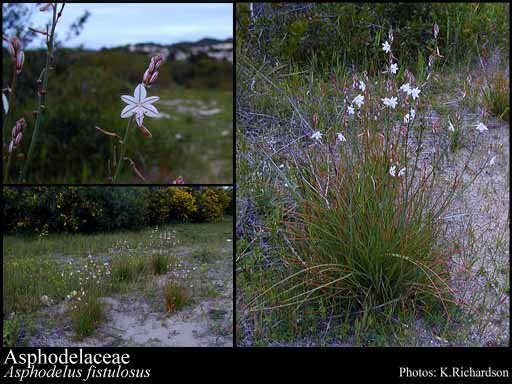- Reference
- Gen.Pl. [Jussieu] 51 (1785)
- Name Status
- Current







Scientific Description
Family Sometimes included in Liliaceae.
Habit and leaf form. Herbs (mostly), or shrubs, or ‘arborescent’ (some of the woody forms with trunks up to several metres). Plants succulent, or non-succulent. Perennial; plants with a basal concentration of leaves (commonly), or with terminal rosettes of leaves (when woody); rhizomatous, or bulbaceous. Helophytic, or mesophytic, or xerophytic. Leaves small to very large; alternate; spiral (usually), or distichous; ‘herbaceous’, or leathery, or fleshy, or leathery and fleshy; sessile; sheathing. Leaf sheaths with free margins. Leaves simple. Leaf blades entire; linear, or lanceolate, or ovate, or subulate (etc.); parallel-veined (but the veins often invisible externally); without cross-venules. Leaf blade margins entire, or serrate, or dentate (and often with an apical spine). Stem anatomy. Secondary thickening absent, or anomalous; when present, from a single cambial ring. Roots. Roots with velamen (in some genera), or without velamen.
Reproductive type, pollination. Fertile flowers hermaphrodite. Unisexual flowers absent. Plants hermaphrodite (usually). Floral nectaries present. Nectar secretion from the gynoecium (via septal nectaries).
Inflorescence and flower features. Flowers aggregated in ‘inflorescences’; in racemes, or in spikes. The terminal inflorescence unit racemose. Inflorescences scapiflorous; terminal; simple or compound racemes or spikes. Flowers bracteate; small to large; regular to very irregular; when irregular, zygomorphic. The floral asymmetry involving the perianth, or involving the perianth and involving the androecium. Flowers 3 merous; cyclic; pentacyclic. Perigone tube present (often, as a long, commonly curved tube), or absent. Perianth with distinct calyx and corolla, or of ‘tepals’; 6; 2 -whorled (3+3); isomerous; sepaloid and petaloid, or petaloid; similar in the two whorls, or different in the two whorls; green, or white, or yellow, or red, or pink, or purple, or brown, or purple and brown (not blue or violet). Androecium 6. Androecial members free of the perianth; all equal, or markedly unequal; free of one another; 2 -whorled (3+3). Androecium exclusively of fertile stamens. Stamens 6; diplostemonous; alterniperianthial. Anthers dorsifixed; dehiscing via longitudinal slits; introrse; tetrasporangiate. Pollen shed as single grains. Gynoecium 3 carpelled. The pistil 3 celled. Carpels isomerous with the perianth. Gynoecium syncarpous; eu-syncarpous; superior. Ovary plurilocular; 3 locular. Gynoecium stylate. Styles 1; apical. Stigmas 1; 3 - lobed; dry type (usually), or wet type. Placentation axile. Ovules 2–40 per locule (‘2 to rather numerous’); usually arillate; hemianatropous, or anatropous (nearly orthotropous in Aloe and Asphodelus).
Fruit and seed features. Fruit non-fleshy (nearly always), or fleshy (Lomatophyllum); dehiscent; a capsule. Capsules loculicidal. Seeds endospermic. Endosperm oily. Seeds winged, or wingless. Embryo well differentiated. Cotyledons 1. Embryo achlorophyllous (1/1); straight. Testa encrusted with phytomelan. Seedling. Hypocotyl internode present, or absent. Seedling collar not conspicuous. Cotyledon hyperphyll compact; non-assimilatory. Coleoptile present, or absent. Primary root ephemeral.
Geography, cytology, number of species. Holarctic, Paleotropical, Neotropical, Cape, Australian, and Antarctic. World distribution: widespread Old World, clearly centred in southern Africa. X = (6–)7. About 800 species.